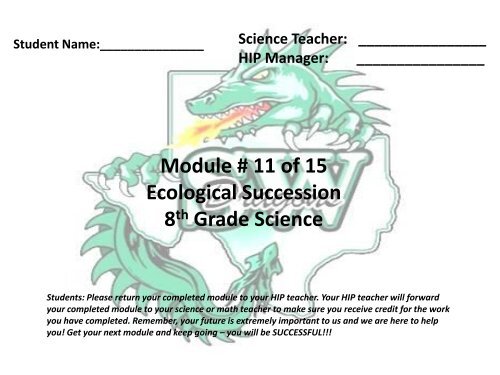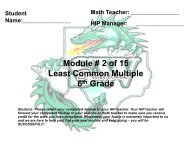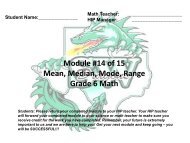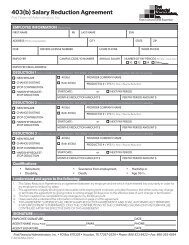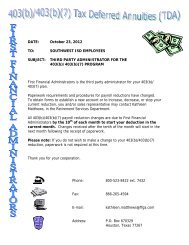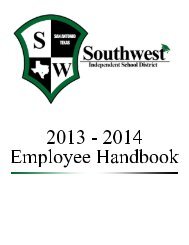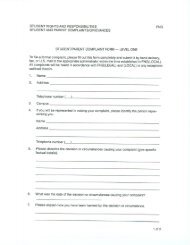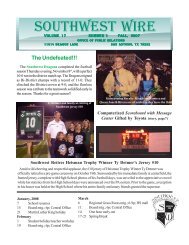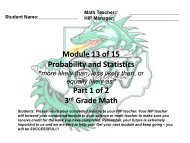Module 11 - Ecological Succession
Module 11 - Ecological Succession
Module 11 - Ecological Succession
Create successful ePaper yourself
Turn your PDF publications into a flip-book with our unique Google optimized e-Paper software.
Student Name:_______________<br />
Science Teacher: ________________<br />
HIP Manager: ________________<br />
<strong>Module</strong> # <strong>11</strong> of 15<br />
<strong>Ecological</strong> <strong>Succession</strong><br />
8 th Grade Science<br />
Students: Please return your completed module to your HIP teacher. Your HIP teacher will forward<br />
your completed module to your science or math teacher to make sure you receive credit for the work<br />
you have completed. Remember, your future is extremely important to us and we are here to help<br />
you! Get your next module and keep going – you will be SUCCESSFUL!!!
Dr. Dragonosky’s Mad<br />
Science Lab Presents<br />
“<strong>Ecological</strong> <strong>Succession</strong>”
<strong>Succession</strong><br />
• <strong>Succession</strong> refers to predictable and orderly<br />
changes in an ecosystem. As plants grow,<br />
more species are introduced to the ecosystem<br />
to make it flourish.<br />
• There are two kinds of succession:<br />
– Primary succession<br />
– Secondary succession
Primary <strong>Succession</strong><br />
• Primary succession occurs in a new area where no<br />
growth has ever been before. Organisms begin to live<br />
in a area where there is no soil. As these organisms die<br />
and decompose, they leave behind nutrients to make<br />
soil. A seed may have been blown by the wind to this<br />
location, and plants begin to grow.<br />
Primary means<br />
“first”. The first<br />
species to appear in<br />
an area are called the<br />
“pioneer species”.<br />
http://www.kscience.co.uk/as/module5/succession/images/succession.jpg
So Remember!!<br />
Think!!!!<br />
• Primary <strong>Succession</strong> = Birth of An Ecosystem<br />
• Nothing there before<br />
• Life slows invades and changes its
Time to Practice!
Why are the following not<br />
examples of primary succession?<br />
Why is a volcanic eruption not an example of<br />
primary succession? Explain?<br />
_____________________________________<br />
_____________________________________<br />
_____________________________________<br />
_____________________________________<br />
Why is a forest fire not an example of primary<br />
succession? Explain?<br />
_____________________________________<br />
_____________________________________<br />
_____________________________________<br />
_____________________________________
Why are the following not<br />
examples of primary succession?<br />
Why is a flood not an example of primary<br />
succession? Explain?<br />
_____________________________________<br />
_____________________________________<br />
_____________________________________<br />
_____________________________________<br />
Why is a tsunami not an example of primary<br />
succession? Explain?<br />
_____________________________________<br />
_____________________________________<br />
_____________________________________<br />
_____________________________________
Time to Practice!
Which of the following is the best<br />
example of primary succession?
Which of the following is the best<br />
example of primary succession?
One More Time: <strong>Succession</strong><br />
• <strong>Succession</strong> refers to predictable and orderly<br />
changes in an ecosystem. As plants grow,<br />
more species are introduced to the ecosystem<br />
to make it flourish.<br />
• There are two kinds of succession:<br />
– Primary succession<br />
– Secondary succession
Secondary <strong>Succession</strong><br />
• Secondary succession occurs<br />
after a mature ecosystem<br />
experiences damage where<br />
all the living things are<br />
destroyed at the surface.<br />
The living things begin to<br />
grow a second time after the<br />
disaster.<br />
• Causes include, forest fires,<br />
drought, human impact,<br />
volcanic eruptions, flooding,<br />
pollution, other natural and<br />
manmade disaster.<br />
http://www.scienceclarified.com/images/uesc_10_img0552.jpg
Natural Disasters<br />
• So remember, natural<br />
disasters wipeout the<br />
ecosystem.<br />
• The ecosystem must<br />
start anew.<br />
• Over time it comes<br />
back, on its own from<br />
the little that is left.
Examine the picture below!!<br />
Place in a large 1, 2, and 3 on each one<br />
to outline the correct order.
Describe What You See Below!!<br />
Stage 1<br />
Stage 2<br />
Stage 3<br />
Stage 4<br />
____________<br />
____________<br />
____________<br />
____________<br />
____________<br />
____________<br />
____________<br />
____________<br />
____________<br />
____________<br />
____________<br />
____________<br />
____________<br />
____________<br />
____________<br />
____________
Time to Practice!
Which of the following might<br />
cause secondary succession?
Which of the following might<br />
cause secondary succession?
Lets sum it up!!!
Answer the following questions:<br />
1. Which organisms can be found in primary succession?<br />
_____________________________________________________________<br />
2. What are three factors that might impact an ecosystem to make it go to<br />
secondary succession? _______________________,<br />
_____________________, and ________________________.<br />
3. When the pioneer species die, what do they leave behind?<br />
_____________________________________________________________
Congratulations!!!<br />
Job well done, and we will see you again<br />
in<br />
“Dr. Dragonosky’s<br />
Mad Science Lab!!”


